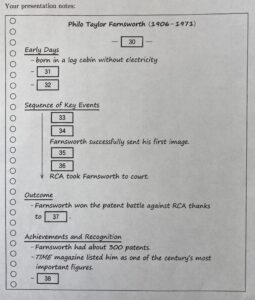今回は、第4問 を終えて
第5問 に入ります。
基本的な問題の扱い方
今回、このブログでは、
共通テスト(英語)の「リーディング」の問題だけを扱うこととします。
基本的な問題の扱い方は、下記の通りにします。
①問題の提示
※基本的には「大問」毎に扱う予定ですが、問題の量などによりそれより細かく区切って取り扱うこともあります。
②模範解答の提示
③解説
④そのほかの補説
第5問:配点15点 ▶︎各3点(問2・3は全部正解のみ得点)
それでは、第5問 の問題を見ていきましょう。
In your English class, you will give a presentation about a great inventor.
You found the following article and prepared notes for your presentation.
※実際の問題では、最初の部分に
Farnsworth in 1939 と下に書かれたイラストが示されています。
|
ー Who invented television? It is not an easy question to answer. In the early ー Philo Taylor Farnsworth was born in a log cabin in Utah in 1906. His ー One day, while working in his father’s potato field, he looked behind him ー On September 7, 1927, Farnsworth succeeded in sending his first ー However, Farnsworth was not the only one working on such a system. A ー The company took legal action against Farnsworth, claiming that ー Farnsworth died in !971at the age of 64 . He held about 300 US and |

問1 Which is the best subtitle for your presentation? 【 30 】
① A Young Inventor Against a Giant Company
② From High School Teacher to Successful Inventor
③ Never-Ending Passion for Generating Electricity
④ The Future of Electronic Television
問2 Choose the best two options for【 31 】and【 32 】to complete Early
Days. (The order does not matter.)
① bought a generator to provide his family with electricity
② built a log cabin that had electricity with the help of his father
③ enjoyed reading books on every subject in school
④ fixed and improved household equipment for his family
⑤ got the idea for an electronic television system while working in a filed
問3 Choose four out of the five events (①〜⑤) in the order they happened to
complete Sequence of Key Events.
【 33 】→【 34 】→【 35 】→【 36 】
① Farnsworth rejected RCA’s offer.
② Farnsworth shared his idea with his high school teacher.
③ RCA won the first stage of the battle.
④ The US government gave Farnsworth the patent.
⑤ Zworykin was granted a patent for his television system.
問4 Choose the best option for【 37 】to complete Outcome.
① the acceptance of his rival’s technological inferiority
② the financial assistance provided by Tolman
③ the sketches his teacher had kept for many years
④ the withdrawal of RCA from the battle
問5 Choose the best option for【 38 】to complete Achievements and
Recognition.
① He and his wife were given an award for their work with RCA.
② He appeared on TV when Armstrong’s first moon landing was broadcast.
③ His invention has enabled us to watch historic events live.
④ Many teenagers have followed their dreams after watching him on TV.
![]()
👉模範解答と解説は次のページです。



コメント